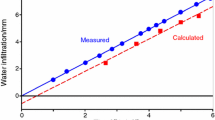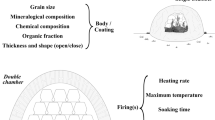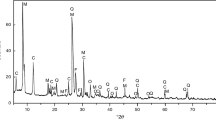Abstract
In this paper, we studied the thermal history of a clay core sample from one leg of a bronze tripod unearthed at Daxinzhuang Site, Shandong, China. The properties of the luminescence signals of quartz depend on the maximum temperature at which the quartz was annealed in the past. We examined the feasibility of measuring the thermoluminescence (TL) sensitivity change of quartz for exploring the firing temperature of archaeological materials. The sensitization factor of the 110°C TL peak (S2/S1) and the ratio of the 210°C TL peak to the 110°C TL peak at different annealing temperatures were utilized to unveil the firing temperature in the clay core sample. The firing temperature of the clay core sample was approximately 700°C–800°C, proving the clay core has been fired. This result proved that the clay core has been fired by human agencies and indicated on the temperature of the clay core in drying and firing given by the foundry workers before the actual casting step.
Similar content being viewed by others
References
Aitken MJ and Smith BW, 1988. Optical dating: recuperation after bleaching. Quaternary Science Reviews 7(3–4): 387–393, DOI 10.1016/0277-3791(88)90034-0.
Bøtter-Jensen L, Andersen CE, Duller GAT and Murray AS, 2003. Developments in radiation, stimulation and observation facilities in luminescence measurements. Radiation Measurements 37(4–5): 535–541, DOI 10.1016/S1350-4487(03)00020-9.
Bøtter-Jensen L and Duller GAT, 1992. A new system for measuring OSL from quartz samples. International Journal of Radiation Applications and Instrumentation. Part D. Nuclear Tracks and Radiation Measurements 20(4): 549–553, DOI 10.1016/1359-0189(92)90003-E.
Department of Archaeology, Shandong University and Shandong Provincial Institute of Cultural Relics and Archaeology, 2010. Tomb No.139 of the Shang Dynasty at Daxinzhuang Site, Jinan city. Kaogu 10: 3–6 (in Chinese).
Godfrey-Smith DI and Ilani S, 2004. Past thermal history of goethite and hematite fragments from Qafzeh Cave deduced from thermal activation characteristics of the 110°C TL peak of enclosed quartz grains. Rev Archéométrie 28: 185–190 (in French).
Goksu HY, Weiser A and Regulla DF, 1989. 110°C TL peak records the ancient heat treatment of flint. Ancient TL 7: 15–17.
Jin ZY, Wu YJ, Li G, Fan AC, Cheng GS and Yan LF, 2012. Luminescence determination of firing temperature of archaeological pure sand related to ancient Dian bronze casting, China. Quaternary Geochronology 10: 387–393, DOI 10.1016/j.quageo.2012.04.010.
Koul DK and Chougaonkar MP, 2011. An attempt to estimate firing temperature using OSL predose sensitization of quartz. Geochronometria 38(3): 217–222, DOI 10.2478/s13386-011-0034-5.
Koul DK, Singhvi AK, Nambi KSV, Bhat CL and Gupta PK, 1996. Feasibility of estimating firing temperature using the 110°C peak of quartz. Applied Radiation and Isotopes 47(2): 191–195, DOI 10.1016/0969-8043(96)82846-6.
Lahaye C, Godfrey-Smith DI, Guibert P and Bechtel F, 2006. Equivalent thermal history (HE) of ferruginous sandstones based on the thermal activation characteristics of quartz. Radiation Measurements 41(7–8): 995–1000, DOI 10.1016/j.radmeas.2006.04.021.
Melcher CL and Zimmerman DW, 1977. TL determination of heat treatment of chert artifacts. Science 197, 1359–1362, DOI 10.1126/science.197.4311.1359.
Polymeris GS, Sakalis A, Papadopoulou D, Dallas G, Kitis G and Tsirliganis NC, 2007. Firing temperature of pottery using TL and OSL techniques. Nuclear Instruments and Methods in Physics Research Section A: Accelerators, Spectrometers, Detectors and Associated Equipment 580(1): 747–750, DOI 10.1016/j.nima.2007.05.139.
Roque C, Guibert P, Vartanian E, Vieillevigne E and Bechtel F, 2004. Changes in luminescence properties induced by thermal treatments; a case study at Sipan and Trujillo Moche sites (Peru). Radiation Measurements 38(1): 119–126, DOI 10.1016/S1350-4487(03)00249-X.
Sunta CM and David M, 1982. Firing temperature of pottery from pre-dose sensitization of TL. PACT 6: 460–467.
The Centre for East Asian Archaeology Studies of Shandong University, 2008. The trial-excavation report of Daxinzhuang site in Jinan City Shandong Province in the autumn of 1984. Dongfang Kaogu (East Asia Archaeology) 4, 288–530 (in Chinese).
Watson IA and Aikten MJ, 1985. Firing temperature analysis using the 110°C TL peak of quartz. Nuclear Tracks and Radiation Measurements 10(4–6): 517–520, DOI 10.1016/0735-245X(85)90052-3.
Author information
Authors and Affiliations
Corresponding author
About this article
Cite this article
Wu, Y., Jin, Z., Fan, A. et al. Firing temperature of a clay core sample in a bronze tripod from Daxinzhuang Site in China using TL techniques. Geochron 40, 317–321 (2013). https://doi.org/10.2478/s13386-013-0122-9
Received:
Accepted:
Published:
Issue Date:
DOI: https://doi.org/10.2478/s13386-013-0122-9




